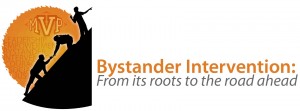International gathering of bystanders: Taking action to prevent sexual and domestic violence
 I developed a workshop many years ago to help participants consider what policy and collective actions they could take to prevent sexual violence and domestic violence. We assigned groups of audience members to be part of different groups where they brainstormed what policies and actions these groups could do to prevent violence. The groups included “Educators”, “Business Owners”, “The Media”, “Faith Leaders”, and an association that I made up called the “National Association of Bystanders.”
I developed a workshop many years ago to help participants consider what policy and collective actions they could take to prevent sexual violence and domestic violence. We assigned groups of audience members to be part of different groups where they brainstormed what policies and actions these groups could do to prevent violence. The groups included “Educators”, “Business Owners”, “The Media”, “Faith Leaders”, and an association that I made up called the “National Association of Bystanders.”
Last week, I think I actually stumbled into that group just like the fictional National Association. Actually I think it should be called a group of international bystander activists. At the Bystander Intervention: From its roots to the road ahead Conference in Boston, MA, I had the opportunity to learn from and share with hundreds of bystander intervention advocates from all over the world to examine where the work has been and where is bystander intervention going in the future.
Bystander intervention is a hot topic right now in sexual violence and domestic violence prevention. Last year, the journal Violence Against Women released an entire issue of bystander research. The are books on the topic like Alan Berkowitz‘s Response Ability. There is an eLearning unit on engaging bystanders from NEARI and National Sexual Violence Resource Center. There are many great programs being implemented throughout the country including Mentors in Violence Prevention (who organized this conference), Green Dot, Coaching Boys into Men, and more. I just saw that Start Strong Boston and Futures without Violence released a workshop guide Moving from a Relationship Bystander to a Relationship UPSTANDER. (Check out bystander intervention on the PreventConnect wiki for more resources.)
The conference began with Richard Freeland describing bystander intervention as the revolutionary third way to prevent sexual and domestic violence. Instead of being potential victims or potential perpetrators, the audience are potential bystanders. Leah Aldridge described being an active bystander means that one becomes a social change agent who is part of the solution. Many of the speakers described the social justice framework of Mentors in Violence Preventin (MVP) bystander intervention programs.
Here are just a few more of my highlights:
- Jackson Katz challenged the notion that “if it help one person it is worth it.” IF it helps only one person, it probably is not a good allocation of resources to prevent the problem. He highlighted that we need to make systematic changes in order to prevent violence.
- Debra Robbin from Jane Doe, Inc. gave thoughtful consideration to how we have to find new ways to talk about gender inclusivity.
- Ron Slaby identified 3 key ingredients of bystander intervention program: (1) develop a bystander perspective using concrete examples (2) develop bystander efficacy beliefs so people believe that they can make a difference, and (3) practice bystander intervention actions in advance.
- Richard Lapchick inspired me (and the entire audience) with his stories about the power of sports to transform society.
- Dorothy Edwards of Green Dot, gave advice on getting funding including “have an excellent program. Don’t suck.”
- Vicki Banyard talked about some of the bystander intervention research she is working on. There are some exciting new studies that will be coming out in the next few years.
- Great tweets using the hashtag #MVPConference2012 – thanks to @sjlaskey @ems_healthyu @sacchipatlel @trinid4 @sethavakia @DonMcPherson @PaulAng44 @Graham_vru @rippleofhope @StopItNow
Soon I will have some podcasts from interviews I conducted at the conference. I was great to meet in person so many PreventConnect community members I knew only online.
If you were there, what were your impressions of the conference?

THank you for the update! I regretfully could not attend the conference due to lack of funding here in out rural community. But I am happy to say our pilot program here in Northern California, Quincy (Plumas County) has had a very urgent and grateful response to this new Bystander program. I feel I need proper training to lead this community into a further light on how to change some of these social norms in our area. I have been in contact with Alan Berkowitz and he is willing to come here for a conference… but again we lack funding. Wouldn’t it be great to combine our efforts here in Norhern California to a conference/ training for Facilitators and student leaders who want to excellerate further as Active Bystanders? Check out our website and let me know if our zero funding efforts could assist in making this possible for other rural and smaller communities in our state to take part in a much needed affordable conference! Thank you CALCASA!